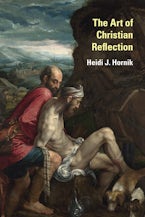In this work, Heidi Hornik shows us how art can transform our sensitivities to contemporary moral issues and attune us to beauty and virtue that brings us closer to God. To walk with her through the visuals assembled here is to embark on what she aptly describes as a 'pilgrimage'; without doubt our journey will lead us far beyond the trifling.
~Samuel E. Balentine, Professor of Old Testament and Director of Graduate Studies, Union Presbyterian Seminary
This stunning book by Heidi Hornik is a rich resource for Christian reflection and action. The formal and iconographic analyses of eighty carefully chosen works of visual art are skillfully integrated with interpretations of biblical texts, important Christian habits and virtues, contemporary moral issues, and formative and liturgical practices of the church. These discussions begin with explorations of what these works of visual art mean, how they are crafted, and how they dialogue with biblical texts and other Christian contexts. But the true focus and most enduring aspects of Hornik’s book are the enlightening insights about what these works of visual art want from us, how they challenge us to respond in our daily lives as Christians.
~David B. Gowler, The Dr. Lovick Pierce and Bishop George F. Pierce Chair of Religion, Oxford College of Emory University
Heidi Hornik’s book is remarkable. Both a respected scholar of Renaissance art history and an avowed Christian, she uses her historical understanding to illuminate great works of art and her religious perspective to bring these works to bear on moral, ethical, and devotional issues facing contemporary people of faith. The book is at once accessible to the layperson--both religious and art historical--and fully grounded in scholarship, and its structure allows for brief-but-focused meditations on the beautiful objects chosen, the questions they raise, and even the answers they may provide.
~James Clifton, Director, Sarah Campbell Blaffer Foundation, and Curator, Renaissance and Baroque Painting, Museum of Fine Arts, Houston
In this innovative volume, art historian Heidi Hornik highlights the rich potential visual art offers Christians as they seek to engage with contemporary ethical issues. Over eighty images are brought into fascinating dialogue with a vast array of contrasting subjects, such as forgiveness, virtual reality, vocation and pornography. Professor Hornik’s thought-provoking approach is to be warmly welcomed, opening up unexplored and fruitful territory.
~Christine E. Joynes, Director, Centre for Reception History of the Bible at the University of Oxford
The Art of Christian Reflection considers the power of images to engage the viewer on a spiritual level by examining a rich array of both familiar and strikingly unusual narrative works and sacred spaces from Early Christian times to the twentieth century. Hornik’s essays provide views into how iconic images and ecclesial buildings have always helped to navigate individuals through complex ethical and moral issues, matters which continue to concern contemporary people every day.
~Robert Randolf Coleman, Professor Emeritus of Art History, University of Notre Dame
In a time when many art historians tread lightly around the spiritual implications of religious art, Heidi Hornik embraces the principles that inspired the artists who created them. Her sometimes surprising meditations remind us of the timeless quality of these works. Demonstrating a broad knowledge of art from the Early Christian period through the nineteenth century, Hornik discusses a rich variety of paintings, mosaics, and sculptures, stimulating new understandings of the biblical texts that inspired them. She includes examples that will extend the visual repertoire of many scholars and encourage new thinking about many old favorites. Her analyses range from traditional readings of canonical standards to surprising spiritual reflections on lesser-known images.
~Judith W. Mann, Curator of European Art to 1800, Saint Louis Art Museum
Selected from the journal Christian Reflection, The Art of Christian Reflection assembles for the first time in one place Heidi Hornik’s research into an impressive array of themes, ultimately giving insight into a Christian perspective on the conduct of one’s life and the search for meaning. Though Hornik’s essays were written for a lay Christian audience, any lover of art of any faith or creed would find much profit in reading Professor Hornik’s explication of the power of art to lay bare the human condition.
~Gustav Medicus, Associate Professor of Art History, Kent State University
The 80-some works of Christian art she selected reflect the gamut of the Christian enterprise and emphasize the ethical role of the arts in addressing matters ranging from racism, poverty, and violence to feminism and environmentalism. Expanding traditional boundaries, Hornik looks at Christian art as narrative appropriate for prayer, praxis, Bible study, and worship.
~Choice
Through the interweaving of visual analysis, scripture, and historical context, Hornik draws her audience into the narratives surrounding works of art and connects them to elements of Christian discipleship. The resulting effect is that the reader feels pulled into a form of embodied discipleship that is not meant to be merely absorbed but to be engaged in as an active participant.
~Holland Prior, Reading Religion

